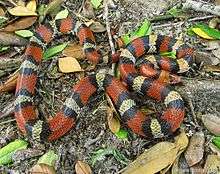Cemophora coccinea
| Cemophora coccinea | |
|---|---|
 | |
| scarlet snake | |
| Scientific classification | |
| Kingdom: | Animalia |
| Phylum: | Chordata |
| Class: | Reptilia |
| Order: | Squamata |
| Suborder: | Serpentes |
| Family: | Colubridae |
| Genus: | Cemophora |
| Species: | C. coccinea |
| Binomial name | |
| Cemophora coccinea (Blumenbach, 1788)[2] | |
| Synonyms | |
| |


Cemophora coccinea, commonly known as the scarlet snake, is a species of nonvenomous snake in the family Colubridae. The species is native to the southeastern United States. There are two subspecies of C. coccinea that are recognized as being valid. The Texas scarlet snake was previously considered a subspecies.
Description
The scarlet snake is relatively small, growing to a total length (including tail) of 14-26 inches (36–66 cm) at adult size. The dorsal pattern consists of a light gray ground color, with a series of black-bordered red blotches down the back. The belly is a uniform light gray color.
The dorsal blotches can extend down the sides of the body, appearing somewhat like banding or rings, which sometimes leads to confusion with other sympatric species such as the venomous coral snakes or the harmless scarlet king snake.
Behavior
The scarlet snake is nocturnal, and generally spends the day hiding under leaf litter or fallen logs, and ventures out in the evenings to forage for food.
Diet
C. coccinea feeds on lizards, small rodents, reptile eggs, and even other snakes.
Reproduction
The scarlet snakes is oviparous, generally laying 3-8 eggs per clutch. Breeding occurs throughout the spring months, and eggs are laid throughout the summer and hatch in the early fall.
Geographic distribution
C. coccinea is found only in the United States, in: southeastern Texas, eastern Oklahoma, Arkansas, Louisiana, Mississippi, Alabama, Georgia, Florida, South Carolina, North Carolina, Tennessee, Kentucky, Illinois, Indiana, Virginia, Maryland, and Delaware; with disjunct populations in New Jersey and central Missouri.
In Indiana, the scarlet snake is listed as an endangered species.[6]
Subspecies
- Cemophora coccinea coccinea (Blumenbach, 1788) – Florida scarlet snake
- Cemophora coccinea copei Jan, 1863 – northern scarlet snake
Nota bene: A trinomial authority in parentheses indicates that the subspecies was originally described in a genus other than Cemophora.
References
- ↑ Hammerson, G.A. 2007. Cemophora coccinea. The IUCN Red List of Threatened Species 2007: e.T63740A12712279. http://dx.doi.org/10.2305/IUCN.UK.2007.RLTS.T63740A12712279.en. Downloaded on 28 September 2018.
- ↑ "Cemopora coccinea ". ITIS (Integrated Taxonomic Information System). www.itis.gov
- ↑ Boulenger GA (1894). Catalogue of the Snakes in the British Museum (Natural History), Volume II., Containing the Conclusion of the Colubridæ Aglyphæ. London: Trustees of the British Museum. (Taylor and Francis, printers). xi + 382 pp. + Plates I-XX. (Genus Cemophora, p. 213; species Cemophora coccinea, p. 214).
- ↑ Williams KL (1967). "A Review of the Colubrid Snake Genus Cemophora Cope". Tulane Studies in Zoology 13 (4): 103-124.
- ↑ Wright & Wright, p. 113.
- ↑ Indiana Legislative Services Agency (2011), "312 IAC 9-5-4: Endangered species of reptiles and amphibians", Indiana Administrative Code, retrieved 28 Apr 2012
Further reading
- Behler JL, King FW (1979). The Audubon Society Field Guide to North American Reptiles and Amphibians. New York: Alfred A. Knopf. 743 pp. ISBN 0-394-50824-6. (Cemophora coccinea, pp. 592–593 + Plates 595, 596, 607).
- Blumenbach JF (1788). "Einige Naturhistorische Bemerkungen bey Gelegenheit einer Schweizer-Reise". Magazin für das Neueste aus der Physik und Naturgeschichte 5: 13-24. (Coluber coccineus, new species, p. 11). (in German and Latin).
- Conant R (1975). A Field Guide to Reptiles and Amphibians of Eastern and Central North America, Second Edition. The Peterson Field Guide Series. Boston: Houghton Mifflin. xviii + 429 pp. + Plates 1-48. ISBN 0-395-19979-4 (hardcover); ISBN 0-395-19977-8 (paperback). (Cemophora coccinea, pp. 211–212 + Plates 30, 31 + Map 152).
- Conant R, Bridges W (1939). What Snake Is That?: A Field Guide to the Snakes of the United States East of the Rocky Mountains. (with 108 drawings by Edmond Malnate). New York and London: D. Appleton-Century. Frontispiece map + viii + 163 pp. + Plates A-C, 1-32). (Cemophora coccinea, pp. 85–86 + Plate 26, Figure 78).
- Powell R, Conant R, Collins JT (2016). Peterson Field Guide to Reptiles and Amphibians of Eastern and Central North America, Fourth Edition. Boston and New York: Houghton Mifflin Harcourt. xiv + 494 pp., 207 Figures, 47 Plates. ISBN 978-0-544-12997-9. (Cemophora coccinea, pp. 367–368 + Figure 159 on p. 330 + Plates 32, 44).
- Schmidt KP, Davis DD (1941). Field Book of Snakes of the United States and Canada. New York: G.P. Putnam's Sons. 365 pp. (Cemophora coccinea, pp. 193–194, Figure 60).
- Smith HM, Brodie ED Jr (1982). Reptiles of North America: A Guide to Field Identification. New York: Golden Press. 240 pp. ISBN 0-307-13666-3 (paperback). (Cemophora coccinea, pp. 178–179).
- Stejneger L, Barbour T (1917). A Check List of North American Amphibians and Reptiles. Cambridge, Massachusetts: Harvard University Press. 125 pp. (Cemophora coccinea, p. 91).
- Wright AH, Wright AA (1957). Handbook of Snakes of the United States and Canada. Ithaca and London: Comstock. 1,105 pp. (in two volumes) (Cemophora coccinea, pp. 111–115, Figure 36, Map 13).
- Zim HS, Smith HM (1956). Reptiles and Amphibians: A Guide to Familiar American Species. A Golden Nature Guide. New York: Simon and Schuster. 160 pp. (Scarlet snake, Cemophora doliata, pp. 100, 156).
External links
| Wikimedia Commons has media related to Cemophora coccinea. |
